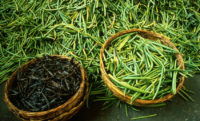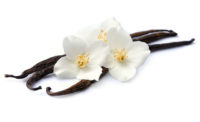Vanilla prices are expected to remain high the first half of 2017 amid projections of adequate-to-poor bean quality, Nielsen-Massey Vanillas says in a state-of-the-market report released Monday.
The Waukegan, Ill.-based firm says several factors — including unsustainable production practices — contribute to the market’s volatility and continued drops in bean condition and supply.
“Growing consumer expectations for pure and all-natural foods and ingredients have spurred global food manufacturers to embrace the use of pure vanilla in recent years, which has driven up global demand dramatically and resulted in massive price hikes,” says Craig Nielsen, Nielsen-Massey v.p. of sustainability. “Because it takes several years for vanilla growers to bring on incremental capacity, this pricing volatility has attracted market speculators and created many dynamics that have hurt farmers and negatively affected product quality.”
Cured bean prices are projected at $400-$450 per kilo at the start of 2017, up from $225-$240 dollars last year. Green bean prices rose from $30 to $80 per kilo in 2016.
Nielsen-Massey says Madagascar produces up to 80 percent of the world’s vanilla supply and, as a result, exerts a strong influence over prices.
Government regulation of harvesting, curing and sales kept bean prices steady until 1995, when Madagascar, under pressure from the World Bank and the European Union, implemented a free-trade system that gave farmers more control. Political instability, a damaging cyclone in 2000 and the entrance of speculators into the market caused prices to soar — and then crash.
Prices hit $25 a kilo between 2006 and 2008, hampering the care and quality of the vanilla beans. However, demand for pure vanilla began to rise in 2013 with interest in pure, natural, non-GMO and Fair Trade products.
At the same time, the practice of vacuum packing, used to preserve fully cured beans, grew to include holding beans in a semi-cured state, allowing collectors or exporters to finish the curing process later and purchase beans at a lower price. But through this method, it’s “impossible to achieve the same quality as through traditional curing methods,” Nielsen-Massey says.
Some green beans undergo the “quick curing” and “extraction” methods, which reduces curing time from six months to several days. These methods provide greater cash flow and control over moisture and desiccation rate, but Nielsen-Massey says they reduce quality and flavor and eliminate jobs for Madagascan workers.
Nielsen-Massey estimates 2017 yields will be adequate-to-poor, as a result of inadequate enforcement of early-picking and vacuum-packing bans, as well as in increased use of the quick-curing and extraction methods.
But there’s still hope. Madagascar is expected to have higher yields of cured vanilla over the next few years, with 2017’s yield projected to hit 1,400-1,800 tons. Between 11 and 14 percent will be produced through quick-curing and extraction.
Indonesia is projected to take the No. 2 spot in 2017, with 200-400 tons expected. Papua New Guinea follows with 150-200 tons expected.
“Even despite the recent vanilla market interruptions, it’s important to reiterate that we have adequate supplies to meet the needs of our customers,” Nielsen says.





